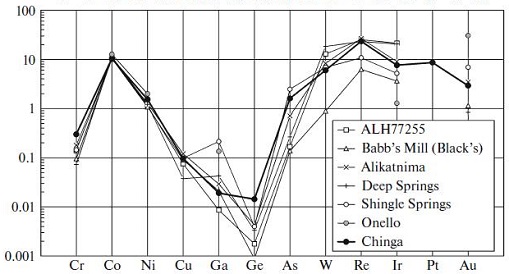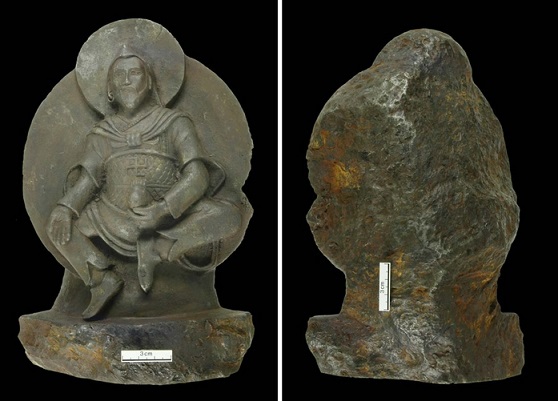Chinga
Iron, IVC, ataxiteWork in Progress Relatively rare variety of iron meteorite (designated type D) made almost entirely of taenite, a solid solution of Fe and 27 to 65% Ni. The Greek name means "without structure" and refers to the lack of a visible Widmanstätten pattern (spindles of kamacite are visible only microscopically). Click on Term to Read More
(Iron-ung in MetBull)
Found 1913
51° 3′ 30′ N., 94° 24′ 0′ E. Many flattened, shrapnel-like iron masses having a combined weight of ~210 kg were found along the Chinge stream bed in Tannu Tuva, which at the time was a small independent country between Mongolia and Siberia. A search for an associated craterBowl-like depression ("crater" means "cup" in Latin) on the surface of a planet, moon, or asteroid. Craters range in size from a few centimeters to over 1,000 km across, and are mostly caused by impact or by volcanic activity, though some are due to cryovolcanism. Click on Term to Read More was conducted in 1963 but none was found as the fallMeteorite seen to fall. Such meteorites are usually collected soon after falling and are not affected by terrestrial weathering (Weathering = 0). Beginning in 2014 (date needs confirmation), the NomComm adopted the use of the terms "probable fall" and "confirmed fall" to provide better insight into the meteorite's history. If Click on Term to Read More is estimated to have occurred 10–20 t.y. ago. Because the meteoriteWork in progress. A solid natural object reaching a planet’s surface from interplanetary space. Solid portion of a meteoroid that survives its fall to Earth, or some other body. Meteorites are classified as stony meteorites, iron meteorites, and stony-iron meteorites. These groups are further divided according to their mineralogy and Click on Term to Read More contains an average of 16.75 wt% nickel, it forms a macroscopically featureless surface structure (micro-plessite). Small inclusions are present, including kamaciteMore common than taenite, both taenite and kamacite are Ni-Fe alloys found in iron meteorites. Kamacite, α-(Fe,Ni), contains 4-7.5 wt% Ni, and forms large body-centered cubic crystals that appear like broad bands or beam-like structures on the etched surface of a meteorite; its name is derived from the Greek word Click on Term to Read More spindles, mm-scale troiliteBrass colored non-magnetic mineral of iron sulfide, FeS, found in a variety of meteorites. Click on Term to Read More, daubreelite, and schreibersiteNi-Fe phosphide mineral, (Fe,Ni)3P, yellowish in color and predominantly found in iron and stony-iron meteorites. Schreibersite can also be found in a variety of other meteorites including some acapulcoites, aubrites, enstatite chondrites and achondrites, lunars, ureilites, winonaites and a smattering of other meteorite types like CM, CO and CB. Schreibersite Click on Term to Read More, and schlieren bands occur in the metallic groundmass. Various features of shearing and plastic deformation are related to a violent event in space.
(µ notation denotes deviation from terrestrial standards in parts per million)

mouseover for alternate view Diagram credit: Worsham et al., EPSL, vol. 467, p. 165 (2017)
‘Characterizing cosmochemical materials with genetic affinities to the Earth: Genetic and chronological diversity within the IAB iron meteoriteIron meteorites consist mostly of metallic iron alloyed with typically between ~5 to ~30 wt% nickel. The main metal phases are kamacite α-(Fe, Ni) and taenite y-(Fe, Ni). Based on their group classification, they may also contain a small weight percentage of one or more of the following minerals: • Click on Term to Read More complex’
(https://doi.org/10.1016/j.epsl.2017.02.044) Mo vs. Ru Isotope Compositions of Irons

Diagram credit: Bermingham et al., EPSL, vol. 487, p. 226 (2018)
‘New insights into Mo and Ru isotope variation in the nebulaAn immense interstellar, diffuse cloud of gas and dust from which a central star and surrounding planets and planetesimals condense and accrete. The properties of nebulae vary enormously and depend on their composition as well as the environment in which they are situated. Emission nebula are powered by young, massive Click on Term to Read More and terrestrial planetThe term "planet" originally comes from the Greek word for "wanderer" since these objects were seen to move in the sky independently from the background of fixed stars that moved together through the seasons. The IAU last defined the term planet in 2006, however the new definition has remained controversial. Click on Term to Read More accretionary genetics’
(https://doi.org/10.1016/j.epsl.2018.01.017) HSE Abundances of IVB and Ungrouped Irons

Diagram credit: Honesto et al., 37th LPSC, #1374 (2006) Importantly, Litasov et al. (2018) determined that Chinga shares compositional similarities with six other ungrouped irons: ALH 77255, Alikatnima, Babb’s Mill (Blake’s), Deep Springs, Onello, and Shingle Springs. In addition, they demonstrated that these seven irons plot between the IVA and IVB groups on all elemental diagrams utilized in their study, and therefore they proposed that these irons be combined together into a new transitional subgroup termed IVC. Trace ElementSubstance composed of atoms, each of which has the same atomic number (Z) and chemical properties. The chemical properties of an element are determined by the arrangement of the electrons in the various shells (specified by their quantum number) that surround the nucleus. In a neutral atom, the number of Click on Term to Read More Distribution

Classification Diagrams (Chinga is the starSelf-luminous object held together by its own self-gravity. Often refers to those objects which generate energy from nuclear reactions occurring at their cores, but may also be applied to stellar remnants such as neutron stars. symbol)
click on diagrams for a magnified view

click on diagrams for a magnified view Diagrams credit: Litasov et al., Doklady Earth Sciences, vol. 478, #1, pp. 64–65 (Jan. 2018)
‘Trace Element Composition and Classification of the Chinga Iron Meteorite’
(https://doi.org/10.1134/S1028334X18010063) A sculpture made from an iron meteorite that is petrologically and geochemically consistent with that of Chinga was transported from Tibet to Germany in 1938–39 (see below). This carved figure, weighing ~10.6 kg (3rd largest Chinga mass known), is probably a portrayal of the Hindu (or Buddhist) god of both wealthiness and war, Kubera (or Vaiśravana), but it could also be a deity associated with the 11th century Bon religion of western Tibet. An estimated date for the sculpture is 8th–11th century, but a more recent date cannot be ruled out.

Photo credit: Buchner et al., MAPS, vol. 47, #9, p. 1496 (Jan. 2012)
‘Buddha from space—An ancient object of art made of a Chinga iron meteorite fragment’
(https://doi.org/10.1111/j.1945-5100.2012.01409.x) Further geochemical and isotopic analyses are required to better resolve the potential relationships that may exist among the members of the proposed IVC subgroup. The specimen of Chinga shown above is a 43.3 g polished partial slice, beautifully photographed by KD Meteorites.








